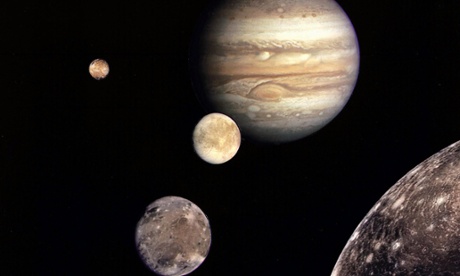The BepiColombo spacecraft, which will become the third probe to visit Mercury, has been unveiled ahead of a mission that will tackle some of the deepest mysteries of our solar system.
The spacecraft, scheduled to launch in October 2018, will investigate the existence of water ice at Mercury’s poles and its volcanoes, and attempt to explain the surprising discovery that the solar system’s smallest planet appears to be shrinking. Mercury remains the most elusive of the solar system’s inner planets, partly due to the challenges involved in building a spacecraft robust enough to withstand the “pizza oven” conditions at the planet.
“Mercury is the least explored of the rocky planets, but not because it is uninteresting,” said Prof Alvaro Giménez Cañete, the director of science at the European Space Agency. “It’s because it’s difficult – difficult to get there, even more difficult to work there.”
BepiColombo is a joint venture between ESA and the Japanese space agency, Jaxa, and comprises a pair of spacecrafts (one per agency) that will be bolted together in a 6.4-metre-high stack before its launch from Kourou in French Guiana. The two crafts – Europe’s Mercury Planetary Orbiter (MPO) and Japan’s Mercury Magnetospheric Orbiter (MMO) – will separate again on arrival at Mercury, more than seven years later.
The length of the journey is not because Mercury is far, but because the spacecraft needs to be going slowly enough to enter a stable orbit rather than crashing into the planet when it arrives. This is a particular problem for Mercury, where an incredibly thin atmosphere means that braking is inefficient.
Prof Mark McCaughrean, a senior adviser at the European Space Agency, said: “You could get there in three months, but you’d need an enormous amount of propellant to slow down again.”
To get around this, BepiColombo will perform a cleverly choreographed series of fly-bys – one at Earth, two at Venus and six at Mercury – designed to slow it down. “By the time we’re injected into orbit we will have gone around the solar system 18.5 times, and we’ll just bleed off the last bit of energy,” said McCaughrean.
Although most of its scientific equipment will be hidden within to shield it from radiation, the craft features a “selfie-stick” camera to take images during its fly-bys.
Mercury is difficult to study in detail using Earth-based telescopes, due to the sun’s glare. So far, only two previous missions have visited: Mariner 10 in the 1970s and Nasa’s Messenger, which orbited the planet from 2011 until it crashed into the planet in 2015.
These missions appear to have raised more questions than answers, with Mercury consistently failing to slot neatly into existing theories of planetary formation and behaviour.
Due to its small size, scientists previously assumed that Mercury’s iron core would have cooled and solidified, in contrast to the Earth’s. However, measurements by Messenger revealed the planet has a magnetic field, which indicates a liquid interior. BepiColombo will make measurements designed to reveal the planet’s internal structure in greater detail.
The mission will also provide comprehensive coverage of the planet’s polar regions to investigate the presence of water ice in the permanently shadowed craters there. Measuring the exact chemical composition of the ice could help solve where it came from in the first place – one possibility is that it was delivered by comets.
The low pressure on Mercury means that, even if the polar regions were warm enough, liquid water would never be present because it would go straight from ice to gas.
There is also the shrinking issue. As the planet’s core cooled, it contracted, which led to the crust crumpling and fracturing into a rugged landscape. Detailed mapping of the cracks at the surface could help determine how quickly the shrinking is happening and reveal more about the underlying processes driving it.
The mission’s science is expected to significantly improve scientists’ understanding of the formation of our solar system, including whether Mercury was “born” at its current position next to the sun, or started its life further out and migrated inwards.
The mission has been in development for two decades, and has suffered a series of delays, after prototypes failed tests and engineers struggled with the challenge of building something capable of coping with the intense heat and radiation experienced a few tens of millions of kilometres from the sun.
Developing solar cells that could both withstand the extreme heat and extract enough energy was particularly difficult, the scientists said at a briefing at the ESA headquarters in Noordwijk, The Netherlands.
“We’re flying into a pizza oven,” said Esa project manager Ulrich Reininghaus. “We had to test materials at different, very high temperature regimes, sometimes with very unwanted results.”
Last month, the spacecraft stack completed its final series of tests, which involved the stack being placed inside an acoustic chamber, where the walls are fitted with powerful speakers that reproduce the noise of launch. The complete stack was shaken at a range of frequencies, both in up-down and side-to-side motions.
Once the spacecraft arrives, the two components are designed to last for two years, although because they have some built-in redundancy they might have enough fuel to keep them going for four years.











